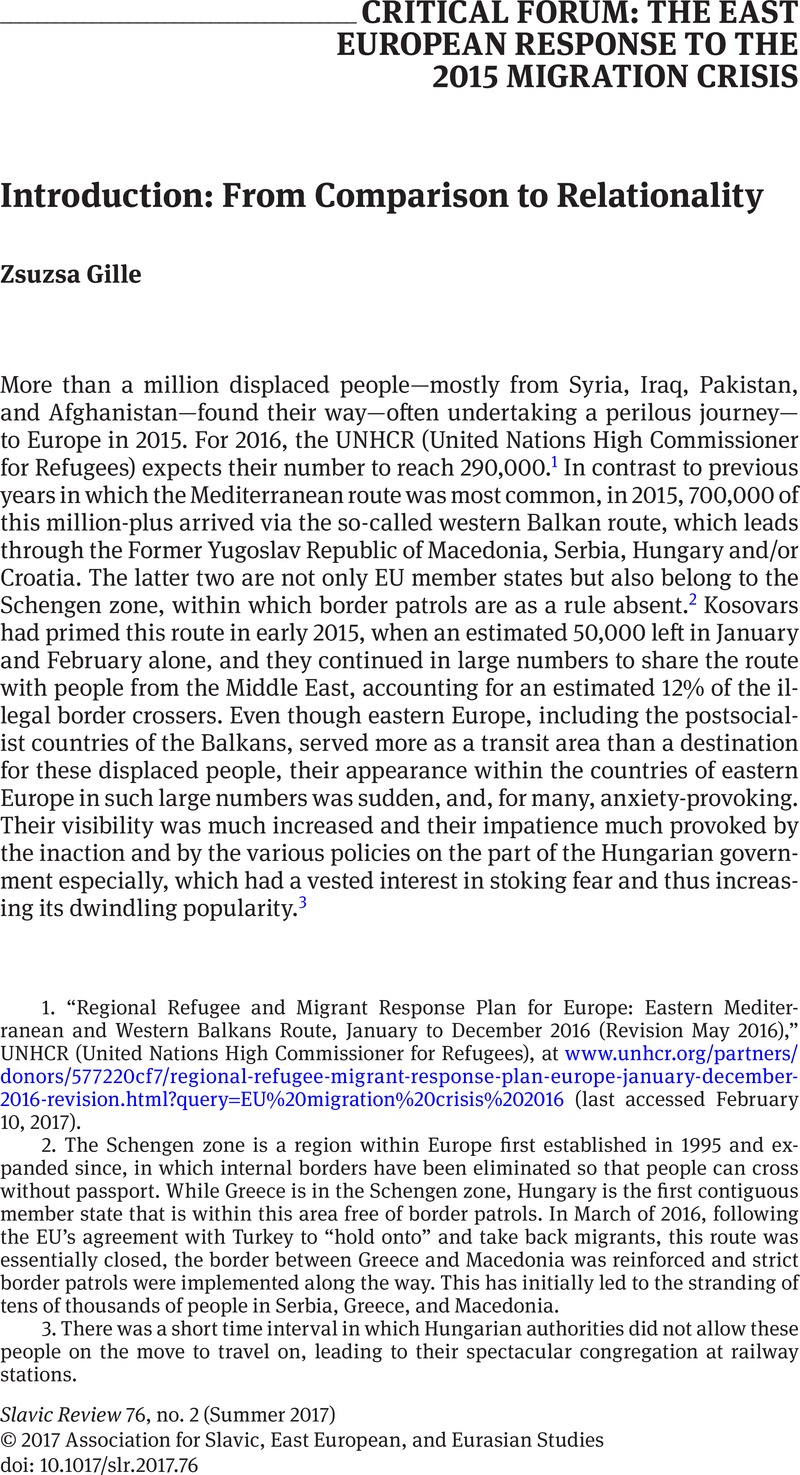Article contents
Introduction: From Comparison to Relationality
Published online by Cambridge University Press: 07 July 2017
Abstract

Information
- Type
- Critical Forum: The East European Response to the 2015 Migration Crisis
- Information
- Copyright
- Copyright © Association for Slavic, East European, and Eurasian Studies 2017
References
1. “Regional Refugee and Migrant Response Plan for Europe: Eastern Mediterranean and Western Balkans Route, January to December 2016 (Revision May 2016),” UNHCR (United Nations High Commissioner for Refugees), at www.unhcr.org/partners/donors/577220cf7/regional-refugee-migrant-response-plan-europe-january-december-2016-revision.html?query=EU%20migration%20crisis%202016 (last accessed February 10, 2017).
2. The Schengen zone is a region within Europe first established in 1995 and expanded since, in which internal borders have been eliminated so that people can cross without passport. While Greece is in the Schengen zone, Hungary is the first contiguous member state that is within this area free of border patrols. In March of 2016, following the EU’s agreement with Turkey to “hold onto” and take back migrants, this route was essentially closed, the border between Greece and Macedonia was reinforced and strict border patrols were implemented along the way. This has initially led to the stranding of tens of thousands of people in Serbia, Greece, and Macedonia.
3. There was a short time interval in which Hungarian authorities did not allow these people on the move to travel on, leading to their spectacular congregation at railway stations.
4. “Kiderült, Eddig Hányan Lépték át Illegálisan a Határt,” Figyelö Online, June 29, 2016, at www.figyelo.hu/index.php?cid=434775-kiderult--eddig-hanyan-leptek-at-illegalisan-a-hatart (last accessed February 10, 2017).
5. This number refers to so-called first claims. Even though most entrants did not wish to stay in Hungary, according to the Dublin III regulation, refugees must ask for asylum in the country where they first enter the EU. Many refused to register exactly because they did not wish to stay in Hungary. Such refusal to be fingerprinted was used as a justification for the authorities’ inhumane treatment.
6. There had also been a plan, and preparations were indeed made, for erecting a physical barrier on the Romanian border as well, but most likely due to the symbolism of closing off Transylvanian Hungarians from the motherland, this was abandoned.
7. “Serbia’s Vucic hits out at Hungarian migrant fence,” Morning Star, June 19, 2015, at www.morningstaronline.co.uk/a-bddb-Serbias-Vucic-hits-out-at-Hungarian-migrant-fence#.WKNce1Pytph (last accessed February 10, 2017).
8. Poland had initially, that is before the electoral success of the right-wing Law and Justice Party, voted for the measure to reallocate migrants and refugees according a quota in all EU member states.
9. Ivan Krastev, “Eastern Europe’s Compassion Deficit,” The New York Times, September 8, 2015, at www.nytimes.com/2015/09/09/opinion/eastern-europes-compassion-deficit-refugees-migrants.html?_r=0 (last accessed February 10, 2017)
10. Todorova, =Maria, Imagining the Balkans (Oxford, 1997)Google Scholar; Wolff, Larry, Inventing Eastern Europe: The Map of Civilization on the Mind of the Enlightenment (Stanford, 1994)Google Scholar.
11. The Schengen Treaty allows the temporary reimplementation of border control in certain circumstances. The Calais Jungle refers to an encampment, since eliminated, where refugees and migrants mostly from Africa and Syria awaited an opportunity to cross into the U.K. via the Eurotunnel. The conditions in the camp deteriorated significantly when its population ballooned to over 6,000 in 2015.
12. To Hungarians, perhaps the most shocking has been György Konrád. See: Andrew Higgins, “Hungary’s Migrant Stance, Once Denounced, Gains Some Acceptance,” The New York Times, December 20, 2015, at www.nytimes.com/2015/12/21/world/europe/hungary-viktor-orban-migrant-crisis.html (last accessed February 10, 2017)
13. Slavoj Žižek, “Migrants, Racists and the Left,” interview by Ella Whelan, Spiked Review, May 2016, at www.spiked-online.com/spiked-review/article/migrants-racists-and-the-left/18395#.V81Qs0ArI0p, (last accessed February 10, 2017).
14. Vince Chadwick, “Timmermans: Central Europe has ‘No Experience with Diversity,’” POLITICO, September 24, 2015, at www.politico.eu/article/migration-news-diversity-timmermans/ (last accessed February 10, 2017).
15. We have seen several moves in this direction even in our narrower area scholarship, see: Bockman, Johanna, Markets in the Name of Socialism: The Left-Wing Origins of Neoliberalism (Stanford, CA, 2011)CrossRefGoogle Scholar; Rogers, Douglas, “Postsocialisms Unbound: Connections, Critiques, Comparisons,” Slavic Review 69, no. 1 (Spring 2010): 1–15 CrossRefGoogle Scholar; Chari, Sharad and Verdery, Katherine, “Thinking between the Posts: Postcolonialism, Postsocialism, and Ethnography after the Cold War,” Contemporary Studies in Society and History 51, no. 1 (January 2009): 6–34 CrossRefGoogle Scholar; Boyer, Dominic and Yurchak, Alexei, “American Stiob: Or, What Late-Socialist Aesthetics of Parody Reveal about Contemporary Political Culture in the West,” Cultural Anthropology 25, no. 2 (May 2010): 179–221 CrossRefGoogle Scholar. In a way, an earlier debate critical forum on Ukraine on the pages of this journal can also be seen as part of this epistemological endeavor (Slavic Review 74, 4). Whether we agree with Snyder, Timothy’s use of the colonial/postcolonial conceptual apparatus (“Integration and Disintegration: Europe, Ukraine, and the World,” Slavic Review 74, no. 4 [Winter 2015]: 695–707)CrossRefGoogle Scholar, it too was made in the spirit of exploring relations rather than comparing (a methodological move that usually presupposes a good measure of independence of the units compared). I consider applications of coloniality to eastern Europe in whatever variety, one subset of relationality-type arguments ( Gille, Zsuzsa, “Is There a Global Postsocialist Condition?,” Global Society, 24, No. 1 [January 2010]: 9–30 CrossRefGoogle Scholar.)
16. Note this is not the same argument as claiming the existence of some universal trend or phenomenon of which, let us say, German and Serbian responses are particular manifestations.
- 1
- Cited by

